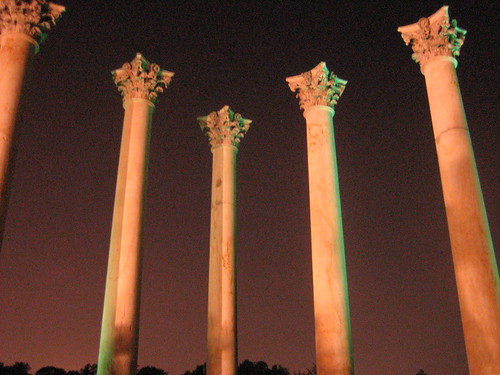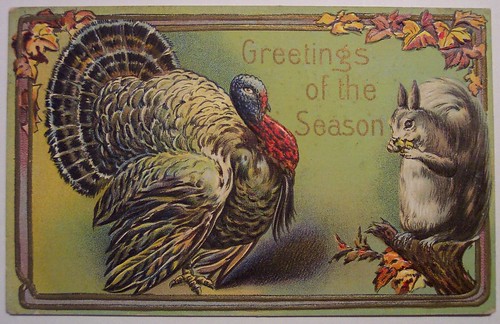As the nights grow longer, we need things to do in the dark. Here are a few natural night-time activities that caught our eye for this week:
One of the most popular activities at the National Arboretum is their monthly full moon hikes. A guide will lead you on a four-mile walk through the arboretum grounds from 7:00 to 9:00 PM. This month's walks are on this Tuesday, Wednesday, and Thursday, Dec. 1-3. Advance registration is required, and last I checked, Thursday's hike was already full. (It's not too early to sign up for January or February!) $22 ($18 for Friends of the National Arboretum).
The Conservatory of the US Botanic Garden on the Mall will stay open until 8:00 PM on several Tuesdays and Thursdays throughout December. And they'll have live music starting at 6:00 PM. Up this week: harps and singing on Tuesday night, and a cappella singing on Thursday. If you can't stand Christmas music, your best bet might be next Tuesday, December 10, when they'll have a klezmer band called Lox and Vodka. The full schedule is here. Free.
Map geeks may want to check out a lecture in observation of the 125th anniversary of the US Geological Survey topographic mapping program on Wednesday at 7:00 PM at USGS headquarters in Reston. Mark DeMulder will "highlight elements of the colorful history of the program and describe the future of topographic mapping at the USGS." Bring a photo ID since it's in a federal office building. Free.
As always, we've got a full schedule of daytime activities up on our calendar as well. See you out there!
Like the photo in this post? Mouse over for credits; a click takes you to the photographer on Flickr.
Monday, November 30, 2009
Thursday, November 26, 2009
Happy Thanksgiving!
Hope you have a nice time with friends and family. We'll be back on Monday!
Meanwhile, check out these Thanksgiving-related posts:
- Turkey Run Park
- wild turkeys
- giving thanks for natural capital and the ecosystem services it provides
- hikes on and after Thanskgiving
Vintage Thanksgiving postcard from this great collection on Flickr.
Tuesday, November 24, 2009
Natural Places in the DC Area To Take Your Out-of-Town Visitors
If you're like us, you've got company coming for Thanksgiving. Some ideas on where to take your guests, for Thanksgiving or at any other time of the year:
Great Falls has always been our default guest-taking spot. There's really nothing like it in the DC area. The views of the falls are great from either side, though the Washington City Paper dubbed Cow Hoof Rock, on the Virginia side, as the best view of the Potomac last year. You have a choice of gentle trails (like the C&O Canal towpath in MD or the Swamp Trail in VA), or rugged trails (like the Billy Goat Trail in MD), for your guests to choose from. $5 admission.
Several Natural Capital readers said they take their guests to the National Arboretum. There's so much to choose from -- everything from very natural-looking and un-manicured Fern Valley, to an indoor bonsai exhibit with trees that have been maintained for hundreds of years. Plus the old Capital columns arranged to look like a Greek temple are a treat for architecture and history buffs. The grounds are open every day from 8 to 5, but the bonsai exhibit is closed on Thanksgiving Day and open on other days only from 10 to 4, so plan accordingly. Free.
If you're going to be down on the Mall, make a detour from all the museums to the US Botanic Garden. Even if you just pop in for a few minutes to see the orchid exhibit, your guests will be impressed. Plus, starting on Thanksgiving, they have a toy train that goes through landscapes and buildings made of sticks, seeds, and other plant-based materials, along with a giant Christmas tree and lots of poinsettias. Free.
Thanksgiving bonus: Take 'em to Turkey Run. Not just for the name -- though that's while we suggest it -- but because it's a pretty spot on the Potomac, where you'll have to climb hills. And we suspect you'll have a few extra calories you'll be wanting to work off this weekend. Free.
Great Falls has always been our default guest-taking spot. There's really nothing like it in the DC area. The views of the falls are great from either side, though the Washington City Paper dubbed Cow Hoof Rock, on the Virginia side, as the best view of the Potomac last year. You have a choice of gentle trails (like the C&O Canal towpath in MD or the Swamp Trail in VA), or rugged trails (like the Billy Goat Trail in MD), for your guests to choose from. $5 admission.
Several Natural Capital readers said they take their guests to the National Arboretum. There's so much to choose from -- everything from very natural-looking and un-manicured Fern Valley, to an indoor bonsai exhibit with trees that have been maintained for hundreds of years. Plus the old Capital columns arranged to look like a Greek temple are a treat for architecture and history buffs. The grounds are open every day from 8 to 5, but the bonsai exhibit is closed on Thanksgiving Day and open on other days only from 10 to 4, so plan accordingly. Free.
If you're going to be down on the Mall, make a detour from all the museums to the US Botanic Garden. Even if you just pop in for a few minutes to see the orchid exhibit, your guests will be impressed. Plus, starting on Thanksgiving, they have a toy train that goes through landscapes and buildings made of sticks, seeds, and other plant-based materials, along with a giant Christmas tree and lots of poinsettias. Free.
Thanksgiving bonus: Take 'em to Turkey Run. Not just for the name -- though that's while we suggest it -- but because it's a pretty spot on the Potomac, where you'll have to climb hills. And we suspect you'll have a few extra calories you'll be wanting to work off this weekend. Free.
Monday, November 23, 2009
Natural Happenings: Burn the Bird
 Most of us will be overeating on Thanksgiving. Good thing our calendar includes lots of options for working off some of those extra calories. Many trips offer carpool options, so you can get out on the trail even if you don't have a car. No excuses!
Most of us will be overeating on Thanksgiving. Good thing our calendar includes lots of options for working off some of those extra calories. Many trips offer carpool options, so you can get out on the trail even if you don't have a car. No excuses!Turkey Day: If you prefer to burn your calories before you consume them, there are two hikes scheduled for Thursday morning. The Center Hiking Club is heading to Sky Meadows to hike 7 miles, including a stretch of the Appalachian Trail. Some of them will be getting together for Thanksgiving dinner afterwards. The DC Metropolitan Hikers are going to Patapsco Valley State Park for an 8 mile hike.
Friday: The Nature Lovers Meetup is taking a 4 mile hike at Great Falls in the morning. The Capital Hiking Club will be there in the evening for a moonlight hike.
Saturday: You can head out with the Sierra Club for an 11 mile hike through Difficult Run, in Reston. Or join the Capital Hiking Club for 9 miles on the Potomac Heritage Trail and the C&O Canal. Register by Wednesday to hike 8 miles on Sugarloaf Mountain with Washington Women Outdoors. Or, if you want to go even farther afield, the Center Hiking Club and the North Virginia Hiking Club are both headed to Shenandoah National Park.
Sunday: The Center Hiking Club will hike 10 miles on the Ridge and Valley Trails in Rock Creek Park. The North Virginia Hiking Club will cover 5-6 miles in Occoquan Regional Park. The Wanderbirds head up toward Frederick for 8-11 miles at Catoctin Mountain Park and Cunningham Falls. The Sierra Club is going to Harper's Ferry for a 7 mile hike at Maryland Heights, and another delegation from the Center Hiking Club is headed to hike Old Rag.
Check our calendar for details on any of these hikes. We'll see you out there!
Like the photo in this post? Mouse over for credits; a click takes you to the photographer on Flickr.
Friday, November 20, 2009
Giving Thanks, or, What Has Your Ecosystem Done For You Lately?
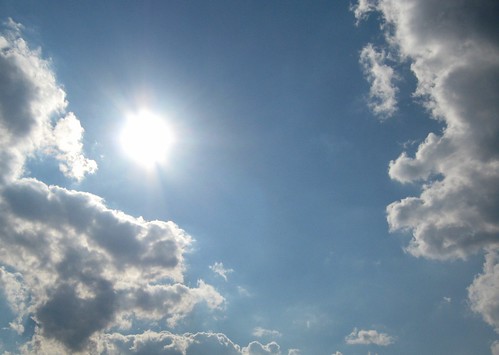 I've been reading the book Natural Capitalism
I've been reading the book Natural Capitalism Natural capital can be viewed as the sum total of the ecological systems that support life, different from human-made capital in that natural capital cannot be produced by human activity. It is easy to overlook because it is the pond in which we swim, and, like fish, we are not aware we're in the water. One can live perfectly well without ever giving a thought to the sulfur cycle, mycorrhizal formation, alleles, wetland functions, or why giant sequoia trees can't reproduce without chattering squirrels...Only when the services provided by ecosystem functions are unmistakably disrupted do we step back and reconsider.
Natural capital can be viewed as the sum total of the ecological systems that support life, different from human-made capital in that natural capital cannot be produced by human activity. It is easy to overlook because it is the pond in which we swim, and, like fish, we are not aware we're in the water. One can live perfectly well without ever giving a thought to the sulfur cycle, mycorrhizal formation, alleles, wetland functions, or why giant sequoia trees can't reproduce without chattering squirrels...Only when the services provided by ecosystem functions are unmistakably disrupted do we step back and reconsider.So, let's step back and consider. Consider the things that the ecosystem you live in is doing for you today, and every day of your life:
- Air to breathe: producing oxygen, purifying air, and regulating the chemical composition of the atmosphere.
- Water to drink: storage, cycling, purification, and distribution of fresh water.
- Food to eat: converting solar energy into food; recycling nutrients and maintaining soil fertility.
- Materials to use: converting solar energy into raw materials; providing a genetic library for food, fibers, pharmaceuticals, and other materials.
- A place to live: managing flooding and soil erosion; regulating the local and global climate; protection against harmful cosmic radiation.

What are you thankful for? Leave us a comment!
Like the photos in this post? Mouse over for credits; a click takes you to the photographer on Flickr.
Thursday, November 19, 2009
LOOK FOR: Wild Turkeys
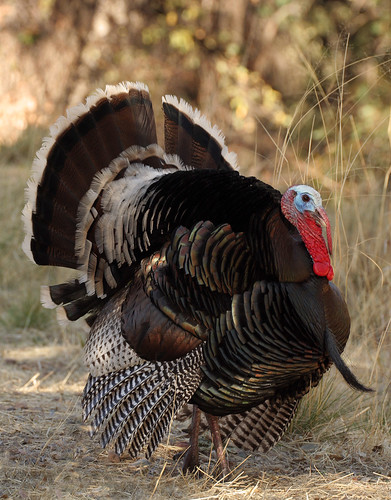 It's almost Thanksgiving, and everybody's thinking of turkey. But long before Thanksgiving existed, turkeys were here in North America.
It's almost Thanksgiving, and everybody's thinking of turkey. But long before Thanksgiving existed, turkeys were here in North America.Turkeys are among the largest birds in our area, with a wingspan over 4 feet and weighing up to 24 pounds. The stereotypical Thanksgiving pose -- tailfeathers fanned out, feathers fluffed up -- is a display that males put on to attract mates, but also when they feel threatened. Not so surprising, then, that this is our picture of turkeys at Thanksgiving time.
As another display tactic, male turkeys have featherless heads that can be bright blue during mating season, complemented by bright red throat, wattles (the floppy part under the beak), snoods (a flap that dangles over the beak), and caruncles (other red growths around the neck and head. Males also have a curious tuft of hairs coming out of the middle of their chests called a beard. If he puts on a successful show, each male typically maintains a harem of several females. Meanwhile, the females can get away with being smaller and less colorful -- in fact, they need to be, as they're the ones that tend the nests.

By the early 1900's, turkey populations in North America had been decimated by hunting. But wildlife managment programs have made a concerted effort to bring the bird back through habitat protection and re-introduction of birds where they had disappeared. For example, the Maryland Department of Natural Resources estimates that the wild turkey population in Maryland has rebounded from about 2,000 turkeys in two or three counties in 1973, to over 30,000 birds in 2008, with wild turkeys in every Maryland county.
In the wild: Turkeys are found throughout Maryland and Virginia in a variety of habitats. In the summer, they seek out areas with berries, grasses, and insects, including both woods and meadows. In the fall and winter, they may increase the time they spend in the woods as they seek out acorns. Many of the times that we have seen wild turkeys have been along rivers; they tend to nest within a few hundred yards of water.
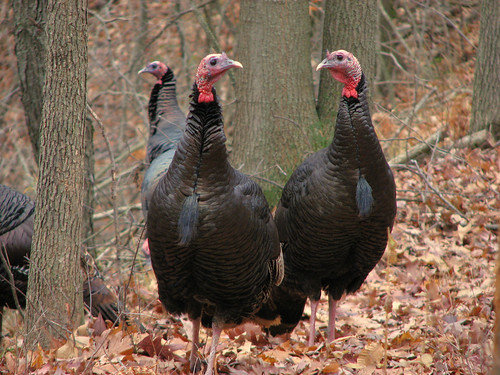 In your yard: Wild turkeys have been known to stray into more urban and suburban areas occasionally, but in general, they're very wary of people. (We have to wonder, though, whether domesticated turkeys will get in on the urban poultry phenomenon at some point.)
In your yard: Wild turkeys have been known to stray into more urban and suburban areas occasionally, but in general, they're very wary of people. (We have to wonder, though, whether domesticated turkeys will get in on the urban poultry phenomenon at some point.)More info:
An excellent report from the Maryland DNR: The Wild Turkey in Maryland
Sounds of Wild Turkeys from the National Wild Turkey Foundation
Like the photos in this post? Mouse over for credits; a click takes you to the photographer on Flickr.
Tuesday, November 17, 2009
Turkey Run Park
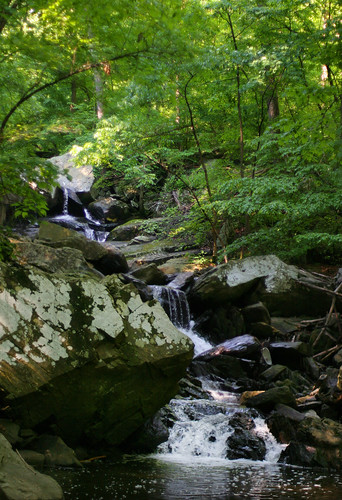 I hate to admit it, but for several years, my main familiarity with Turkey Run was as a spot to turn around when I missed a turn-off on the GW Parkway. It's a shame, because it's a great park, with 700 acres and almost 3 miles of shoreline along the Potomac. We feature it this week in honor of the upcoming Thanksgiving holiday.
I hate to admit it, but for several years, my main familiarity with Turkey Run was as a spot to turn around when I missed a turn-off on the GW Parkway. It's a shame, because it's a great park, with 700 acres and almost 3 miles of shoreline along the Potomac. We feature it this week in honor of the upcoming Thanksgiving holiday.Not surprisingly, since it's just down the river, the topography of Turkey Run is very similar to that of Scott's Run. You'll drop down from upland woods into the rich bottomland flood plain of the Potomac River. And when I say "drop," I mean drop...nearly 200 feet over about a quarter mile of trail. It makes for lovely streams tumbling down to the Potomac...and a tough climb back up.
In the spring, Turkey Run Park is full of wildflowers, especially bluebells along the Potomac. In the fall, it's time to catch the turning leaves. And, once leaves are down, to catch better views of the river.
 You have three good options for loop hikes at Turkey Run. All start by heading down the steep switchback trail that leaves from Parking Lot C:
You have three good options for loop hikes at Turkey Run. All start by heading down the steep switchback trail that leaves from Parking Lot C:- The shortest option is to go left along the Potomac, then follow Turkey Run back uphill and cross over to the parking lot (see the yellow trail on this map). This can be extended by walking along the Potomac and then doubling back. Total hike is only about a mile, but it will feel like more since it's all up and down.
- At the bottom of the switchbacks, if you go to the left, it's about a mile to the next stream, which is called Dead Run. Follow Dead Run uphill and follow these directions to get back to the parking lot. Total hike is 3.9 miles.
- At the bottom of the switchbacks, go right, and hike along the Potomac until you reach the Woods Trail (see the green and pink trails on this map). This will take you up the hill, past Parking Lots A and B, and back to Parking Lot C. Total hike is about 3 miles.
 Other info:
Other info:The entrance to Turkey Run is about 2 miles inside the Beltway (exit 43) on the GW Parkway. It's not accessible by public transportation as far as we can tell.
The park is free and open sunrise to sunset, every day. There are picnic tables, restrooms, and water fountains near the parking lots.
Bikes are not allowed.
Dogs are allowed, but must remain on leash.
Turkey Run Park
McLean, VA, 22101
(703)289-2500
Like the photos in this post? Mouse over for credits; a click takes you to the photographer on Flickr.
Monday, November 16, 2009
Natural Happenings: Looking Up
Did you know the Air and Space Museum has a new 16-inch, 3,000-pound Boller and Chivens telescope on loan from Harvard College Observatory? It will be open to the public on Tuesday night from 5:30 to 7:30. Afterward, stay for the lecture about the Hubble Space Telescope by astronaut John Grunsfeld in the Lockheed Martin IMAX Theater. Free tickets are required for the lecture, but not the telescope.
Still looking up, but a little closer to the ground, there are lots of opportunities to go birding on our calendar every week. For the coming week:
See you out there!
Like the photo in this post? It's by Flickr user CarbonNYC..
Still looking up, but a little closer to the ground, there are lots of opportunities to go birding on our calendar every week. For the coming week:
- The Nature Lover's Meetup has scheduled a Birding and Beer outing to Riverbend Park and Old Brogue pub on Saturday afternoon/evening.
- The Audubon Naturalist Society has several free birding trips on Saturday: an all-day trip to Eastern Neck National Wildlife Refuge, a half day trip to Charles County, and a short morning birding class at their sanctuary in Chevy Chase. On Sunday, there's a paid field trip to Eastern Neck.
- The Prince George's County Audubon Society goes to Lake Artemesia first and third Thursdays at 3:00 PM and first and third Saturdays at 7:30 AM in Bowie (see below).
- The Northern Virginia Audubon Society goes to Huntley Meadows Mondays at 7:00 AM, Dyke Marsh Sundays at 8:00 AM, and Great Falls Sundays at 8:00 AM.
See you out there!
Like the photo in this post? It's by Flickr user CarbonNYC..
Friday, November 13, 2009
Where is Your Favorite Natural Spot to Take Guests?
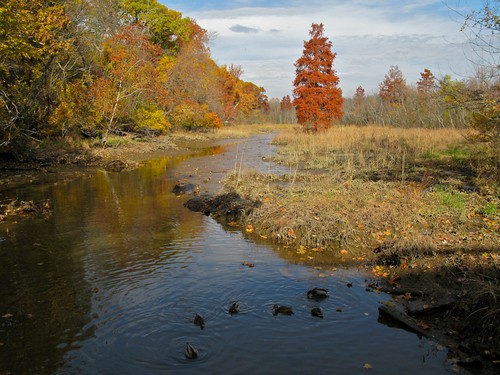 We've got family coming for Thanksgiving. They love to hike (they raised us well). And, since they've been visiting us in the DC area for many years, we've taken them to all our favorite hiking spots. So we thought we'd throw the question out there to you: what's your favorite place to take out-of-town guests at this time of year? We'll round up your answers (and our own) in a post in time for Thanksgiving.
We've got family coming for Thanksgiving. They love to hike (they raised us well). And, since they've been visiting us in the DC area for many years, we've taken them to all our favorite hiking spots. So we thought we'd throw the question out there to you: what's your favorite place to take out-of-town guests at this time of year? We'll round up your answers (and our own) in a post in time for Thanksgiving. Photo of Roosevelt Island on Thanksgiving 2007 is by Michael Foley Photography; click to go to his page on Flickr.
Thursday, November 12, 2009
LOOK FOR: White Throated Sparrows, Back for the Winter
 A few weeks ago, we started seeing white throated sparrows in our yard again. These little birds breed in Canada during the summer, then head south to spend the winter anywhere from Pennsylvania south to Florida, and west to Missouri and Texas.
A few weeks ago, we started seeing white throated sparrows in our yard again. These little birds breed in Canada during the summer, then head south to spend the winter anywhere from Pennsylvania south to Florida, and west to Missouri and Texas.White throated sparrows often hop around on the ground and forage in the leaf litter, where most of their plumage serves as good camouflage. But their head markings stand out, and lend the bird its scientific name, Zonotrichia albicollis: stripe-headed white-throat. These birds do indeed have white throats, often with a thin, dark border. The stripes on top of the head come in two color variations: either black and white or brown and tan. But perhaps most distinctive is the little patch of yellow just above and in front of the eye (a "lore"). This yellow patch stands out to me so much that this, and not the white throat, is usually how I recognize these birds for who they are.
Some people say the song of the white-throated sparrow sounds like they're saying "Oh sweet Canada, Canada, Canada." I find that helps me remember what bird I'm hearing more than the other mnemonic often used for their song: "Poor Sam Peabody, Peabody, Peabody." Anybody could say that (though I'm not sure why Sam Peabody is so deserving of pity). No, these little guys are clearly longing for their summer home. Have a listen:
 In the wild: like many birds, white-throated sparrows like the edges of woods, and suburban backyards. In the winter they eat seeds from grasses and ragweed to grape, rose, and dogwood.
In the wild: like many birds, white-throated sparrows like the edges of woods, and suburban backyards. In the winter they eat seeds from grasses and ragweed to grape, rose, and dogwood.In your yard: White throated sparrows will come to feeders, especially for millet and black oil sunflower seeds, but they prefer to eat the seed scattered on the ground. You can make an area extra-inviting by providing cover (like a brush pile or thicket) and water in a birdbath, pond, or fountain.
Like the photos in this post? Mouse over for credits; a click takes you to the photographer on Flickr.
Wednesday, November 11, 2009
A Week of Links: Busy at Work and Play Edition
We've both been really busy this week...so a few less links than usual, unless you want to read about the work Elizabeth's been doing for the Kaiser Family Foundation (along with several other projects that don't have results yet). But you're here for nature, not the complicated world of Medicare Part D. And we've got some for you:
- Natural ringtones: make your phone ring with bird calls, or animal sounds from the National Zoo.
- And speaking of the National Zoo, here's video of a recent deer vs. lions incident. Are zoo lions so weakened by captivity that they can't decisively take out a deer that strays into their enclosure? And are deer now so overpopulated in Rock Creek Park that they are actively seeking out predators?
- There's a hearing on the Purple Line coming up on Dec. 10. It's a dilemma for nature lovers: do you make the Capital Crescent trail less nice in order to get more cars off the road?
- Lovely pictures of the leaves in Klingle Valley from Valerie Hinojosa.
- Bringing Nature Home to Your Ecosystem Garden: a podcast with author Doug Tallamy.
- How's this for bringing nature into your home? An article from the New York Times home & garden section on Building With Whole Trees.
Autumn is a second spring when every leaf is a flower. - Albert Camus
Tuesday, November 10, 2009
Rainy Day Nature: The Conservatory of the US Botanic Garden
 When I worked on the Mall, the Conservatory of the US Botanic Garden was a key part of my winter survival strategy. If you need a fix of green growing things, or of warm, steamy air, this is your place.
When I worked on the Mall, the Conservatory of the US Botanic Garden was a key part of my winter survival strategy. If you need a fix of green growing things, or of warm, steamy air, this is your place.At any given time, there are about 4,000 plants on display in these Botanic Garden greenhouses. A major highlight for me is the orchid room. Hundreds of orchids are on display at any given time, rotated in and out according to what's blooming. (The USBG's entire collection includes about 5,000 orchids.) What an amazing display of the wonders of evolution. Be sure to smell as well as look -- the white orchids are more likely to have stronger fragrance.
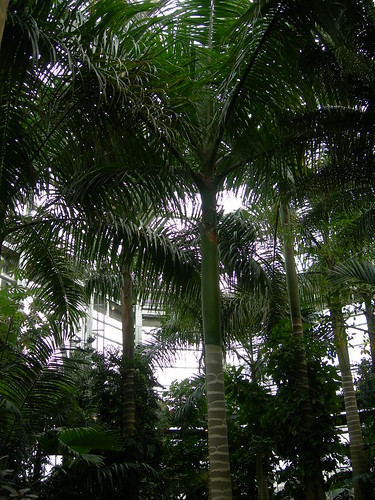 In the center of the Botanic Garden, under a 93 foot dome, is a display in which jungle plants are "overtaking an abandoned plantation." You can walk through the ground floor, or climb up to a balcony that views the canopy of these plants. Keep an eye out for bananas!
In the center of the Botanic Garden, under a 93 foot dome, is a display in which jungle plants are "overtaking an abandoned plantation." You can walk through the ground floor, or climb up to a balcony that views the canopy of these plants. Keep an eye out for bananas!Other sections of the greenhouses reconstruct other environments. One room contains a reconstructed Jurassic landscape of ferns and other ancient plants. Another highlights cacti, succulents, and other flora from deserts around the world. A Hawaii room shows off plants from that tropical paradise. (Do you see why I find this place restorative in the winter?)
For those looking for a human connection, other displays highlight the uses of specific plants: as medicines, and as fibers, food, cosmetics, and other economic goods. And there is an exhibit on the role of plants in culture.
 The human history of the garden itself is also interesting. Apparently, George Washington, Thomas Jefferson, and James Madison all participated in calls to have a national botanic garden. One was established on the Mall in 1820, and this one has been in continuous operation since 1850. The current structure dates to 1933, and is under the jurisdiction of the Architect of the Capitol -- making the Botanic Garden part of the Legislative Branch.
The human history of the garden itself is also interesting. Apparently, George Washington, Thomas Jefferson, and James Madison all participated in calls to have a national botanic garden. One was established on the Mall in 1820, and this one has been in continuous operation since 1850. The current structure dates to 1933, and is under the jurisdiction of the Architect of the Capitol -- making the Botanic Garden part of the Legislative Branch. Admission to all public areas of the U.S. Botanic Garden is free. The Conservatory is open 10 AM to 5 PM daily, including weekends and holidays, with free tours on Mondays and Thursdays at noon. The closest metro is Federal Center SW.
US Botanic Garden
100 Maryland Avenue, SW
Washington, DC 20001
Like the photos in this post? Mouse over for credits; a click takes you to the photographer on Flickr.
Monday, November 9, 2009
Natural Happenings: Hanging out in the Dark, and Becoming Enlightened
 Saturday night is the monthly telescope party at Sky Meadows State Park. The skies there are darker than in the city, so you'll see a lot more if it's a clear night. It's also a great place for a walk, before it gets dark. Someone will give a short night sky orientation at dusk. The only catch is, you'll need to dress warmly at this time of year. There is a $4 parking fee per car. Cover flashlights with a red filter or a brown paper bag -- this will keep you from dilating someone's eyes and ruining their night vision. (And these guys are really serious about their night vision, trust us.) In rain or cloudy weather, there will be a short alternate program.
Saturday night is the monthly telescope party at Sky Meadows State Park. The skies there are darker than in the city, so you'll see a lot more if it's a clear night. It's also a great place for a walk, before it gets dark. Someone will give a short night sky orientation at dusk. The only catch is, you'll need to dress warmly at this time of year. There is a $4 parking fee per car. Cover flashlights with a red filter or a brown paper bag -- this will keep you from dilating someone's eyes and ruining their night vision. (And these guys are really serious about their night vision, trust us.) In rain or cloudy weather, there will be a short alternate program.If you prefer to stay in the city to hang out in the dark, a Rock Creek Park ranger will lead a lantern-lit hike for ages 5+ on Saturday, leaving from Peirce Mill at 5:30 PM. Bring your own flashlight. Rain or severely cloudy weather will cancel this event.
Your weekly dose of enlightenment comes via the Sierra Club - they're leading a 5 mi. (very moderately paced) walk to visit part of the Inter-County Connector (ICC) to examine its impact on stream valleys and watersheds in Montgomery County. "Paint Branch is unique to the area, for supporting the last remaining native brown trout population, and this is a beautiful hike." Meet at 10 am in the parking lot of Valley Mill Park (1600 East Randolph Rd., Silver Spring). Contact leaders for Metro pick-up. Bring a bag lunch and you can continue the conversation after the hike. Leaders: Kris Unger, krisunger@gmail
Like the photo in this post? Mouse over for credits; a click takes you to the photographer on Flickr.
Friday, November 6, 2009
A Poem for Fall
In Blackwater Woods
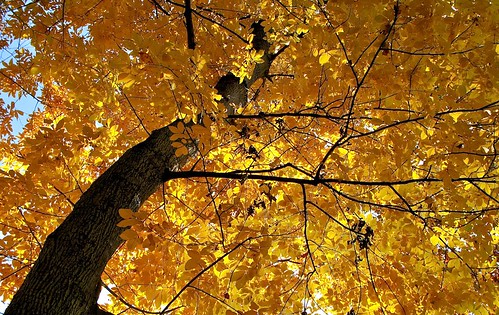 Look, the trees
Look, the trees
are turning
their own bodies
into pillars
of light,
are giving off the rich
fragrance of cinnamon
and fulfillment,
the long tapers
of cattails
are bursting and floating away over
the blue shoulders
 of the ponds,
of the ponds,
and every pond,
no matter what its
name is, is
nameless now.
Every year
everything
I have ever learned
in my lifetime
leads back to this: the fires
and the black river of loss
whose other side
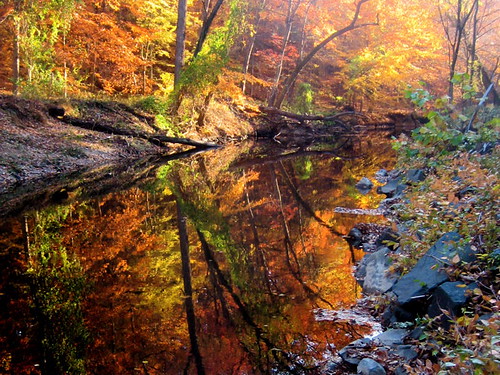 is salvation,
is salvation,
whose meaning
none of us will ever know.
To live in this world
you must be able
to do three things:
to love what is mortal;
to hold it
against your bones knowing
your own life depends on it;
and, when the time comes to let it go,
to let it go.
-- "In Blackwater Woods" by Mary Oliver, from American Primitive , 1983.
, 1983.
Like the photos in this post? Mouse over for credits; a click takes you to the photographer on Flickr.
 Look, the trees
Look, the treesare turning
their own bodies
into pillars
of light,
are giving off the rich
fragrance of cinnamon
and fulfillment,
the long tapers
of cattails
are bursting and floating away over
the blue shoulders
 of the ponds,
of the ponds,and every pond,
no matter what its
name is, is
nameless now.
Every year
everything
I have ever learned
in my lifetime
leads back to this: the fires
and the black river of loss
whose other side
 is salvation,
is salvation,whose meaning
none of us will ever know.
To live in this world
you must be able
to do three things:
to love what is mortal;
to hold it
against your bones knowing
your own life depends on it;
and, when the time comes to let it go,
to let it go.
-- "In Blackwater Woods" by Mary Oliver, from American Primitive
Like the photos in this post? Mouse over for credits; a click takes you to the photographer on Flickr.
Thursday, November 5, 2009
LOOK FOR: Witch Hazel, the Last Flowers of the Year
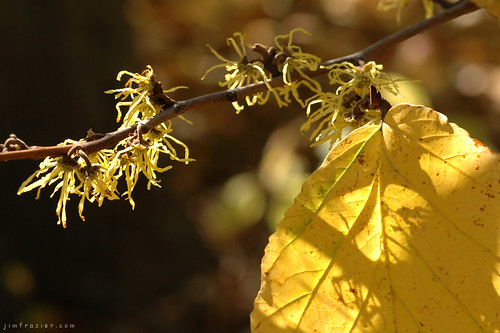 As one of the last things in the DC area to flower in the fall, witch hazel has a special place in my heart. It's not that the flowers are particularly showy -- the petals are just small yellow wisps, really. But the flowers of Hamamelis virginiana start blooming in October, and can keep going until Thanksgiving or even later.
As one of the last things in the DC area to flower in the fall, witch hazel has a special place in my heart. It's not that the flowers are particularly showy -- the petals are just small yellow wisps, really. But the flowers of Hamamelis virginiana start blooming in October, and can keep going until Thanksgiving or even later.Witch hazel (or witchhazel) is an understory shrub that grows up to 20 feet tall. Its flowers are about a half-inch to an inch wide, and they come in clusters of 3-5, on a little stalk coming off the twigs of the shrub. They'll form clusters of seedpods which explode when they're ripe, shooting their seeds up to 30 feet away. You may see some seedpods on the tree at the same time as the flowers are blooming.
 There's another native species of witch hazel that, rather being the last to bloom this year, will be one of the first blooms of next year. Hamemelis vernalis often has redder flowers, and they're slightly smaller. We've never seen it in the wild, so let us know if you see some this winter! There are also Asian species of Hamemelis that are often planted ornamentally that flower in the winter.
There's another native species of witch hazel that, rather being the last to bloom this year, will be one of the first blooms of next year. Hamemelis vernalis often has redder flowers, and they're slightly smaller. We've never seen it in the wild, so let us know if you see some this winter! There are also Asian species of Hamemelis that are often planted ornamentally that flower in the winter.Many people have heard of witch hazel because the bark and leaves have a long history of medicinal use as an astringent. But the "witch hazel" you can now buy in a store actually has very little witch hazel in it. It's made by soaking the leaves or bark in water, distilling it, then adding alcohol. People disagree on whether witch hazel actually has any effectiveness after the distillation process -- it may be the alcohol that's doing most of the good when you use this product. We've never tried making our own -- this tree just isn't common enough to justify it.
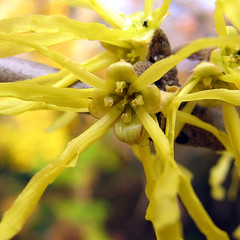 In the wild: Witch hazel likes moist soil, though we've also seen it on dry mountainsides. They're scattered along the Valley Trail in Rock Creek Park -- on our last hike we noticed several directly across Rock Creek from Picnic Area 8 that were in bloom. There used to be a nice stand of small witch hazels on the Rachel Carson trail north of Colesville Road, but a couple of years ago they were taken out by beavers. We'll have to check on whether they've managed to come back.
In the wild: Witch hazel likes moist soil, though we've also seen it on dry mountainsides. They're scattered along the Valley Trail in Rock Creek Park -- on our last hike we noticed several directly across Rock Creek from Picnic Area 8 that were in bloom. There used to be a nice stand of small witch hazels on the Rachel Carson trail north of Colesville Road, but a couple of years ago they were taken out by beavers. We'll have to check on whether they've managed to come back. In your yard: Garden books recommend them, but the witch hazel we planted a few years ago still seems to struggle in the summer. All trees want a lot of water in their first year after planting, but this one perhaps more so.
Where have you seen witch hazel in the DC area? Leave us a comment below.
Like the photos in this post? Mouse over for credits; a click takes you to the photographer on Flickr.
Wednesday, November 4, 2009
A Week of Links: Persimmon Planting Edition
We've always wanted to check out the Edible Landscaping nursery outside of Charlottesville, VA. We went down this past weekend for their persimmon festival, gorged ourselves on fruit, and came back with two persimmon trees that we have squeezed into our yard. (And a few sample fruits for the clients of Matt's Habitats to taste.) We'll post more on persimmons in a few weeks -- they're just starting to ripen up. For now, here are some things we found interesting over the last week:
Delicious autumn! My very soul is wedded to it, and if I were a bird I'd fly about the earth seeking successive autumns. - George Eliot
- Carl Sagan like you've never seen him before: The Symphony of Science.
- Gary Lincoff on the Martha Stewart show talking about collecting wild mushrooms in Central Park.
- Bill Nye the Science Guy, not jumping up and down, just talking intelligently about climate change.
- The Kojo Naamdi Show on outdoor activities for the fall.
- Yet another article on fall hiking in VA and MD.
- A great shot of a woodpecker's tongue.
- Planet Green's top 20 eco-songs: I've seen many of these lists, but I actually like most of the songs here.
- Planning car-free hikes may be getting easier...Montgomery Ride-On is now on Google Transit. (If only Metro were listed. They say they're working on it.)
- How to Make Winning Wildlife Portraits.
- You, too, could test a squirrel's memory.
- New Scientist on the environmental impact of pets - it takes a lot of land and energy to feed them. Plus, cats on average kill 25 wild animals per year.
- Groovy ideas for your Halloween candy windfall from The Green Phone Booth.
Delicious autumn! My very soul is wedded to it, and if I were a bird I'd fly about the earth seeking successive autumns. - George Eliot
Tuesday, November 3, 2009
Scott's Run Nature Preserve
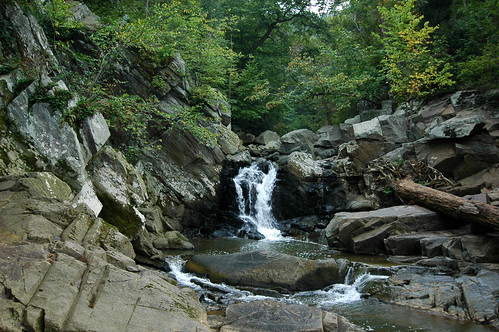 Scott's Run is one of the rare parks in the area that compels us to get into our car and drive on the Beltway just to go hiking there. It's got a small river with multiple small falls that culminate in a 15-foot waterfall as it joins the Potomac. You'll also see birds, wildflowers, and the most extensive population of hemlocks that we know of in the area.
Scott's Run is one of the rare parks in the area that compels us to get into our car and drive on the Beltway just to go hiking there. It's got a small river with multiple small falls that culminate in a 15-foot waterfall as it joins the Potomac. You'll also see birds, wildflowers, and the most extensive population of hemlocks that we know of in the area. This park is perhaps all the more valuable because Scott's Run has a much less lovely beginning: it starts directly below a parking lot at Tyson’s Corner Mall. As it flows to the Potomac, Scott's Run passes through highly-developed Fairfax County. But, in 1970, when this 336 acre tract of land along Scott's Run was slated to be turned into a housing development, citizens banded together and voted in a referendum to tax themselves in order to buy the land for $3.6 million and make it into a park instead. It was a hard-won fight, and we should give thanks every time we visit that things ended the way they did.
 For any hike in this park, be prepared for steep hills as you enter the Potomac river valley. But trails are well maintained, with a range between wide, smooth trails and rock scrambling. There is a map of the park at each trailhead.
For any hike in this park, be prepared for steep hills as you enter the Potomac river valley. But trails are well maintained, with a range between wide, smooth trails and rock scrambling. There is a map of the park at each trailhead.As you'll see on the map, the Potomac Heritage Trail passes through the park. From here, you can follow the PHT from here 10.8 miles south to Roosevelt Island. Trail proponents hope to someday link Scott's Run to Great Falls, which is a little less than 5 miles upstream from Scott's Run. Eventually, they hope to link some 830 miles of trails along the Potomac River.
For something a little shorter, Hiking Upward describes a 2.2 mile loop that takes you through much of the park, similar to the route we often take. We also like the River Trail, on the western side of the waterfall, because it ends up at a nice, secluded spot on the Potomac with views of big rock outcrops across the river.
 As you walk along the Potomac to the east of the Scott's Run waterfall, keep an eye out for long, curved rows of stacked rocks in the river. This is an old fishing weir. The rows of stones channel fish to a single break in the rock wall, where typically a net or a basket would be waiting to catch them. I haven't been able to find any information on how old this structure is -- Native Americans definitely used this technique, but so did colonial settlers. More recently, weirs have been used as a way to protect fish as they're being introduced into a river.
As you walk along the Potomac to the east of the Scott's Run waterfall, keep an eye out for long, curved rows of stacked rocks in the river. This is an old fishing weir. The rows of stones channel fish to a single break in the rock wall, where typically a net or a basket would be waiting to catch them. I haven't been able to find any information on how old this structure is -- Native Americans definitely used this technique, but so did colonial settlers. More recently, weirs have been used as a way to protect fish as they're being introduced into a river.Fishing is allowed, with the appropriate license.
Swimming is not allowed in the park, largely because of health reasons. Do you really want to swim in the storm runoff from Tyson’s Corner? (Which raises a question about fishing, as well, but apparently that's up to you.)
Dogs are allowed in the park, but must remain on leash. And please scoop their poop, or it will just pollute the river that much more.
Bikes are not allowed.
There are no bathrooms or any other facilities at the preserve.
Directions: From the Beltway in McLean, take exit 13. Go left on Georgetown Pike and in less than a mile, turn right into the parking lot. Or, keep going and there's another parking lot, also on the right.
Scott's Run Nature Preserve
7400 Georgetown Pike, McLean, VA 22102
Like the photos in this post? Mouse over for credits; a click takes you to the photographer on Flickr.
Monday, November 2, 2009
Natural Happenings: Art & Nature
There are many, many hikes, bike rides, and other events on our calendar for this week - check it out. It caught our eye that three of the week's offerings are focused on art and nature:
The Audubon Naturalist society is offering a three-part Nature Photography Workshop. It starts Tuesday (tomorrow) night with a class, followed by a field trip to Great Falls on Saturday, and a follow-up to review your work on December 1. "Learn to see and appreciate the creative forms, patterns, and colors in nature," offers the description. The cost is $40 for members of ANS, and $56 for non-members.
The National Museum of Natural History is hosting a Draw-In (aimed at ages 10+) at its Naturalist Center in Leesburg on Saturday from 11:00 to 4:00. The Naturalist Center houses thousands of specimens that don't fit in the NMNH on the Mall, and many will be available for you to sketch. Professional artists will be on hand to demonstrate drawing techniques, answer questions, and offer advice, including a demonstration of coppersmithing at 1:30. Participants need to bring their own art supplies. Free.
Perhaps you'd rather observe art than make it. On Saturday, the Sierra Club is leading a hike through DC to look at several exhibits. They'll start at 2:00 at the National Geographic Museum with the "Polar Obsession" photo exhibit (free); then walk to Corcoran Gallery of Art to see the photo exhibit "Oil" ($10 entry fee); up to the Convention Center to see the "Windows into DC" exhibit, then down to Kennedy Center to see free 6 pm performance on the Millennium Stage ("and perhaps brain overload," admits the organizer). The final leg is a walk back to the Foggy Bottom Metro. For more info: Liz Guertin, eguertin@yahoo.com.
The Audubon Naturalist society is offering a three-part Nature Photography Workshop. It starts Tuesday (tomorrow) night with a class, followed by a field trip to Great Falls on Saturday, and a follow-up to review your work on December 1. "Learn to see and appreciate the creative forms, patterns, and colors in nature," offers the description. The cost is $40 for members of ANS, and $56 for non-members.
The National Museum of Natural History is hosting a Draw-In (aimed at ages 10+) at its Naturalist Center in Leesburg on Saturday from 11:00 to 4:00. The Naturalist Center houses thousands of specimens that don't fit in the NMNH on the Mall, and many will be available for you to sketch. Professional artists will be on hand to demonstrate drawing techniques, answer questions, and offer advice, including a demonstration of coppersmithing at 1:30. Participants need to bring their own art supplies. Free.
Perhaps you'd rather observe art than make it. On Saturday, the Sierra Club is leading a hike through DC to look at several exhibits. They'll start at 2:00 at the National Geographic Museum with the "Polar Obsession" photo exhibit (free); then walk to Corcoran Gallery of Art to see the photo exhibit "Oil" ($10 entry fee); up to the Convention Center to see the "Windows into DC" exhibit, then down to Kennedy Center to see free 6 pm performance on the Millennium Stage ("and perhaps brain overload," admits the organizer). The final leg is a walk back to the Foggy Bottom Metro. For more info: Liz Guertin, eguertin@yahoo.com.
Subscribe to:
Posts (Atom)

